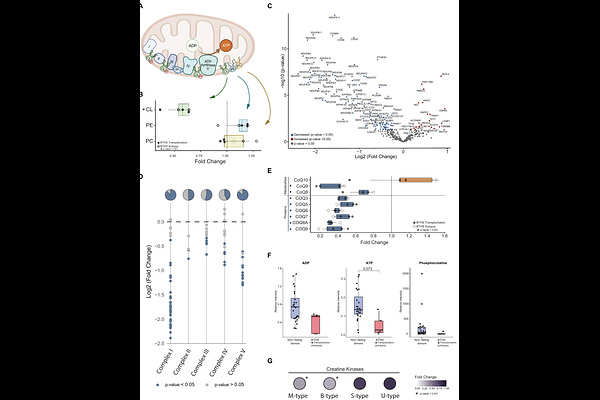Integrated Multi-Omics Mapping of Mitochondrial Dysfunction and Substrate Preference in Barth Syndrome Cardiac Tissue

Integrated Multi-Omics Mapping of Mitochondrial Dysfunction and Substrate Preference in Barth Syndrome Cardiac Tissue
Schomakers, B. V.; Passadouro, A. S.; Tretowicz, M. M.; Simpson, P. J.; Jaspers, Y. R. J.; van Weeghel, M.; Hu, I. M.; Lamboo, C. M. E.; Cloutier, D.; Byrne, B. J.; van Klinken, J. B.; Janssens, P. M.; Piersma, S. R.; Jimenez, C. R.; Vaz, F. M.; Salomons, G. S.; van der Velden, J.; Houtkooper, R. H.; Mosegaard, S.
AbstractBarth syndrome (BTHS) is a rare X-linked recessively inherited disorder caused by variants in the TAFAZZIN gene. The pathogenic variants lead to impaired conversion of monolysocardiolipin (MLCL) into mature phospholipid cardiolipin (CL). The accumulation of MLCL and mature CL deficiency is a diagnostic marker for BTHS. The clinical spectrum includes cardiomyopathy, skeletal myopathy, neutropenia, and delays in growth. In severely affected BTHS patients, the cardiac phenotype is early onset, heterogeneous and unpredictable. Ultimately, these patients may require a cardiac transplant early in their life. Unfortunately, the pathophysiological mechanisms of BTHS are poorly understood, and treatment options for BTHS remain symptomatic. In this study, we analysed heart samples from five paediatric male BTHS individuals (5 month-15 years old) and compared them to tissues from 24 non-failing donors (19-71 years old) using a newly developed integrated omics method that combines metabolomics, lipidomics and proteomics using a single sample. This comprehensive analysis confirms expected changes in established diagnostic markers such as CL and MLCL, as well as severe and pleiotropic alterations in mitochondrial phenotype and metabolic output, a substrate shift in energy metabolism, and an elevation of heart-failure markers. It also reveals striking interindividual differences between BTHS individuals. Combined, we describe a powerful analytical tool for the in-depth analysis of metabolic disorders and a solid foundation for the understanding of BTHS disease phenotypes in cardiac tissues.